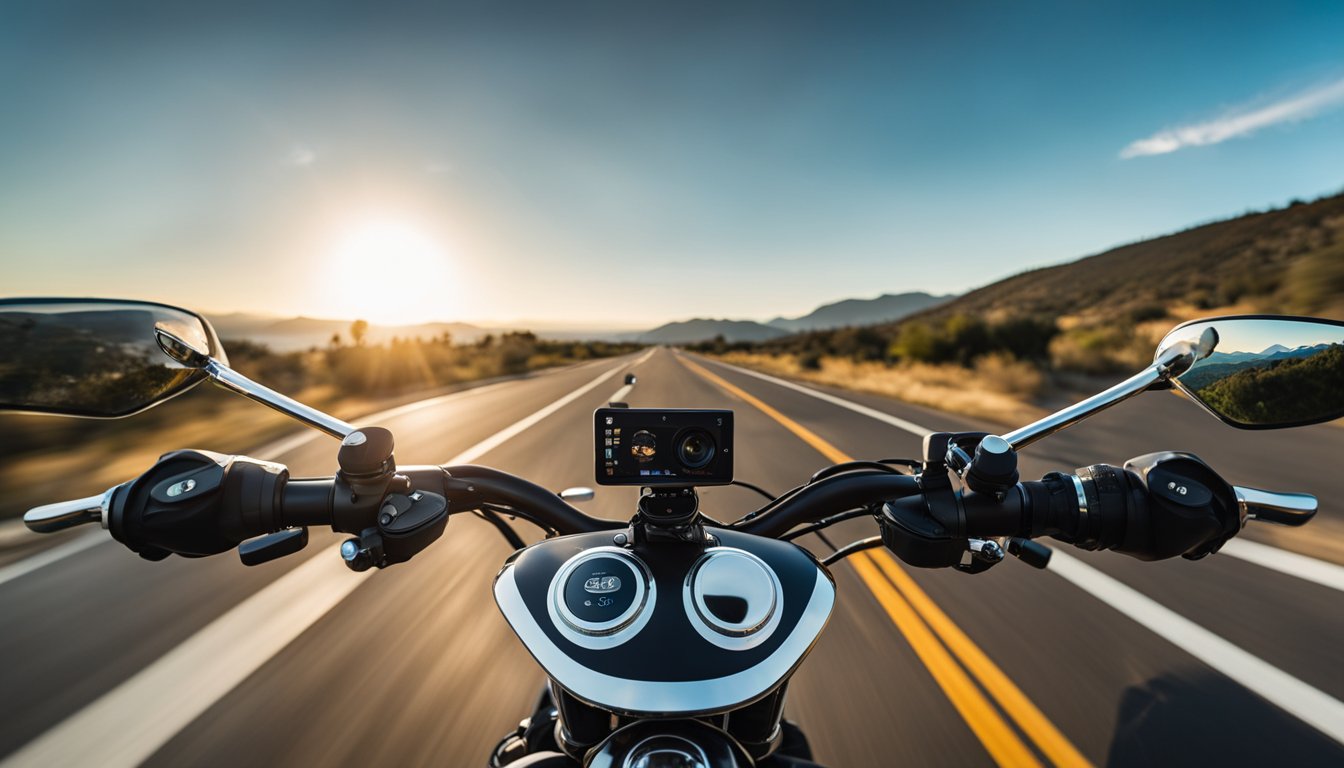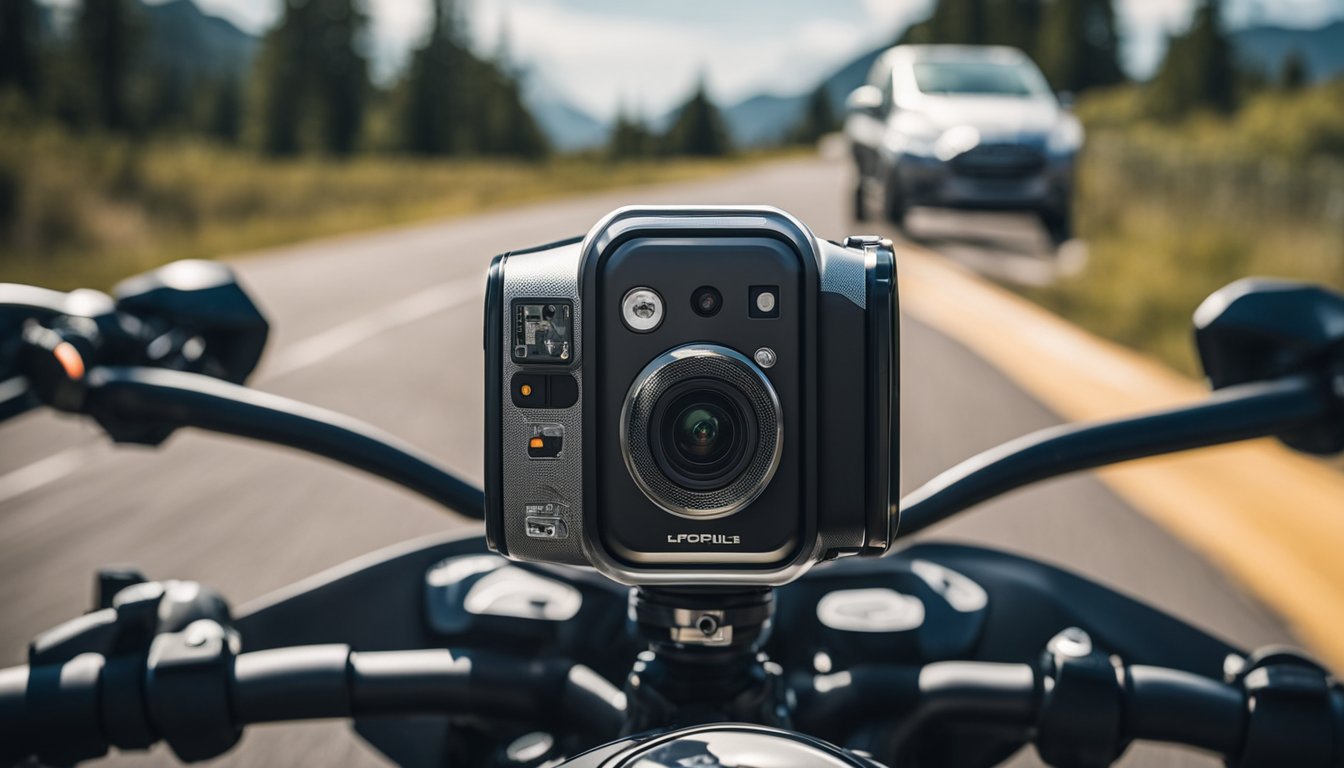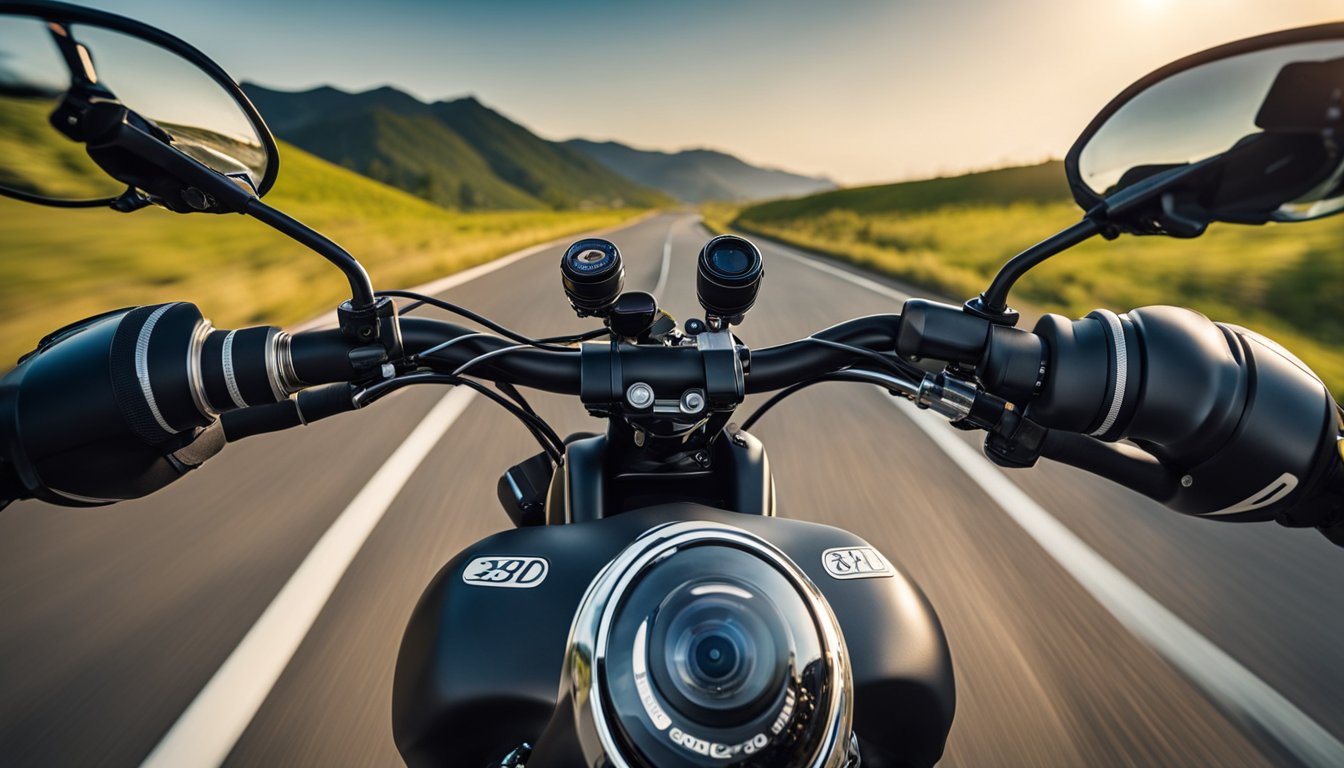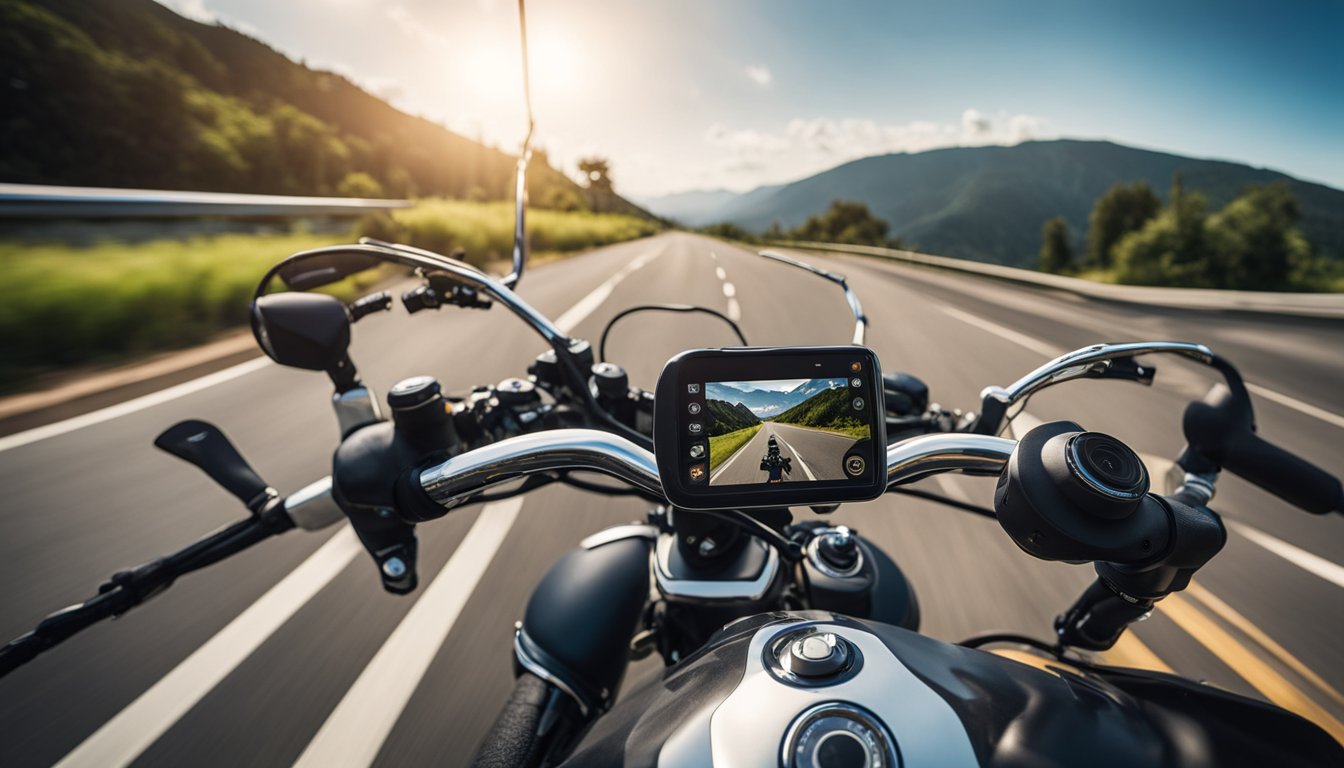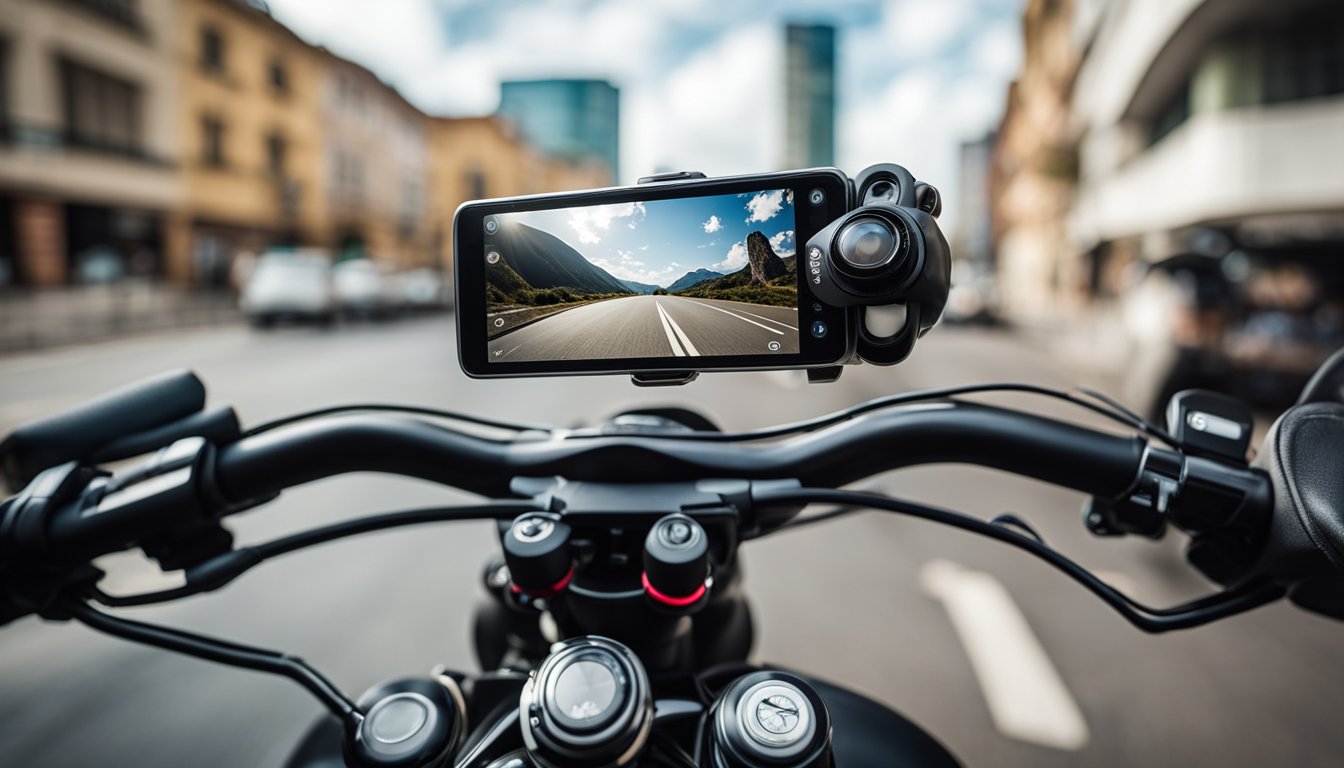360 cameras are becoming increasingly popular among motorcycle enthusiasts. These cameras allow you to capture your ride in a whole new way, providing a complete 360-degree view of your surroundings. But how do they work, and what features should you look for when choosing a 360 camera for your motorcycle?
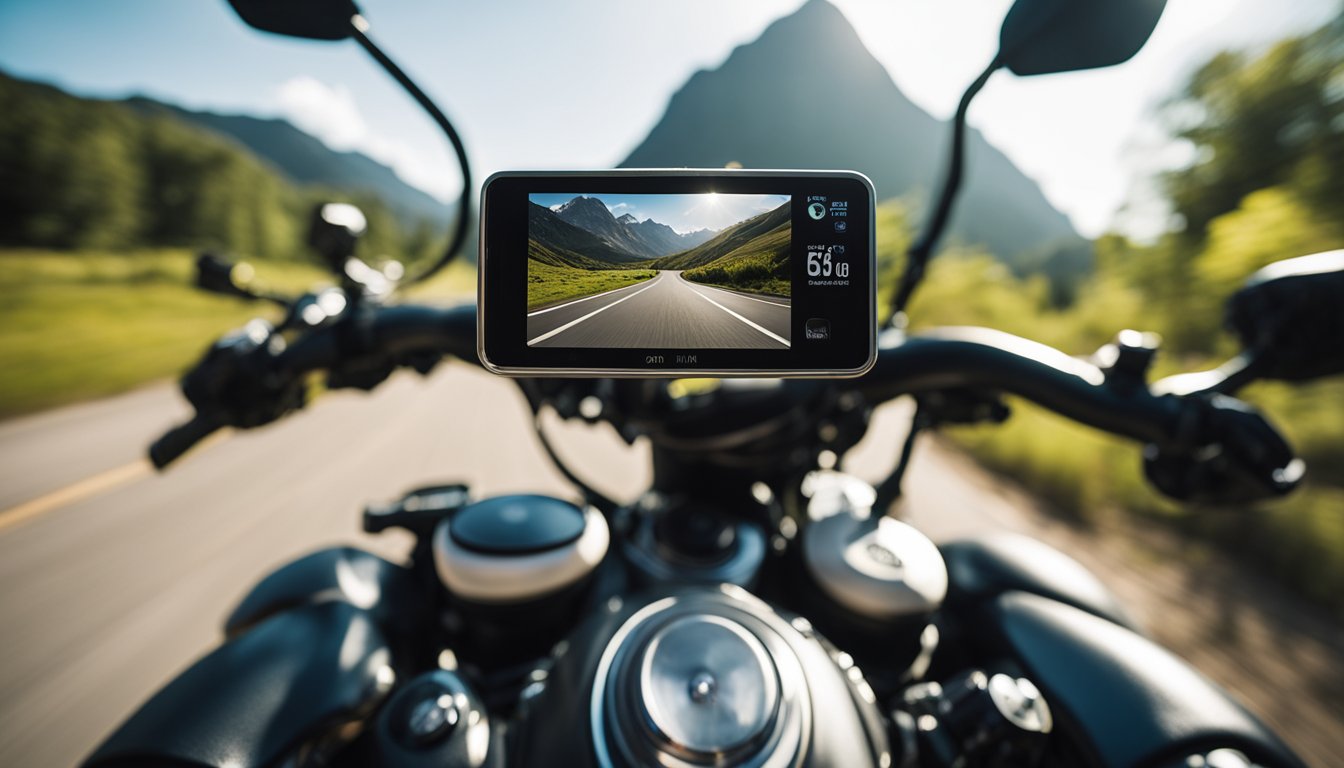
Understanding how a 360 camera works is the first step in choosing the right one for your needs. These cameras are equipped with multiple lenses that are strategically placed around the device, allowing them to capture a full 360-degree view of your surroundings. The lenses capture images simultaneously, which are then stitched together to create a seamless, panoramic view. With a 360 camera, you can capture everything around you, from the road ahead to the beautiful scenery off to the side.
Key Takeaways:

- 360 cameras capture a full 360-degree view of your surroundings using multiple lenses that are strategically placed around the device.
- When choosing a 360 camera for your motorcycle, look for features such as image stabilization, waterproofing, and high-quality video resolution.
- With a 360 camera, you can capture your ride in a whole new way, providing a complete view of your surroundings that enhances the overall riding experience.
Understanding 360 Cameras on Motorcycles
https://www.youtube.com/watch?v=qExPe-nKdfI&embed=true
If you are a motorcyclist who loves to capture thrilling moments on the road, a 360-degree camera is a must-have gadget. In this section, we’ll discuss what a 360-degree camera is and the benefits it offers for motorcyclists.
What Is a 360-Degree Camera?
A 360-degree camera is a device equipped with multiple lenses placed strategically around the device, capturing a full 360-degree view of the surroundings. The camera records the environment in all directions, allowing viewers to experience the motorcycle ride as if they were right there on the bike. The camera captures everything that is happening around the motorcycle, including the scenery, the rider’s movements, and the bike’s speed.
Benefits for Motorcyclists
360-degree cameras offer several benefits for motorcyclists. First, they capture the entire environment, allowing viewers to experience the ride as if they were right there on the bike. This creates a more immersive experience for viewers, making them feel like they are part of the ride. Second, 360-degree cameras are ideal for capturing scenic routes and landscapes. You can record the beautiful scenery and share it with your friends and family. Third, 360-degree cameras are perfect for capturing stunts and tricks. You can record your motorcycle stunts and share them on social media to showcase your skills.
In summary, a 360-degree camera is a must-have gadget for motorcyclists who love to capture thrilling moments on the road. It offers an immersive experience for viewers, captures scenic routes and landscapes, and records stunts and tricks. With the right 360-degree camera, you can create amazing videos that showcase your motorcycle adventures.
Key Features of 360 Cameras
« What is a 360 Camera on a Car? A Beginner’s Guide to the Latest Car Technology
Is 360 Camera Worth It? Pros and Cons to Consider »
Capturing the thrill and excitement of a motorcycle ride can be challenging, but with a 360 camera, you can capture every angle of your ride. A 360 camera is a device that captures a 360-degree view of the surroundings, and it’s an excellent tool for capturing the beauty of the world around you. Here are some of the key features of 360 cameras that you should know about:
Resolution and Video Quality
One of the essential features of a 360 camera is the resolution and video quality. Most 360 cameras can shoot in 4K or 5.7K, which means that you get high-quality footage that looks stunning. The higher the resolution, the better the video quality, and the more detail you can capture. With a 360 camera, you can capture every detail of your ride, from the beautiful scenery to the details of your motorcycle.
Field of View and Image Stabilization
Another essential feature of a 360 camera is the field of view and image stabilization. A 360 camera captures a 360-degree view, which means that you can capture everything around you. It’s an excellent tool for capturing the beauty of the world around you. Image stabilization is also an essential feature of a 360 camera. It helps to reduce camera shake and ensures that your footage is smooth and stable.
Durability and Waterproofing
When you’re riding a motorcycle, you need a camera that can withstand the elements. Most 360 cameras are durable and can withstand the vibrations and shocks of a motorcycle ride. Additionally, many 360 cameras are waterproof, which means that you can use them in any weather condition. Whether you’re riding in the rain or in dusty conditions, a 360 camera can withstand it all.
In summary, 360 cameras are an excellent tool for capturing every angle of your motorcycle ride. They offer high resolution and video quality, a wide field of view, image stabilization, and durability. With a 360 camera, you can capture the beauty of the world around you and relive your motorcycle ride over and over again.
Popular 360 Camera Models for Motorcycling
If you’re an adventurous motorcyclist, you know the importance of capturing your rides in stunning detail. That’s where 360 cameras come in. These cameras are perfect for capturing the entire scene around you, giving you a unique perspective of your rides.
Here are some of the popular 360 camera models that are perfect for motorcycling:
Insta360 Series
Insta360 is one of the most popular 360 camera brands out there, and for good reason. Their cameras are known for their high-quality video and image capture, as well as their ease of use. The Insta360 One X2 is a great option for motorcyclists, as it comes with a variety of mounts that make it easy to attach to your bike. The One X2 also has a built-in stabilization system, which helps to keep your footage smooth even when you’re riding on bumpy terrain.
GoPro Max
GoPro is another popular action camera brand that has recently entered the 360 camera market. The GoPro Max is a great option for motorcyclists, as it is built to withstand tough conditions and has a variety of mounts that make it easy to attach to your bike. The GoPro Max also has a built-in stabilization system, which helps to keep your footage smooth even when you’re riding on bumpy terrain.
Ricoh Theta X
The Ricoh Theta X is a compact and lightweight 360 camera that is perfect for motorcyclists who want to capture their rides in stunning detail. The Theta X has a built-in stabilization system, which helps to keep your footage smooth even when you’re riding on bumpy terrain. It also has a variety of shooting modes, including time-lapse and HDR, which allow you to capture your rides in a variety of different ways.
No matter which 360 camera you choose, make sure to mount it securely to your bike to ensure that it stays in place while you’re riding. With a 360 camera, you’ll be able to capture your rides in stunning detail and relive your adventures over and over again.
Mounting the Camera on Your Motorcycle
https://www.youtube.com/watch?v=8-gqUrxNFHk&embed=true
If you want to capture stunning footage of your motorcycle journey, mounting a 360 camera on your bike is a great way to do it. Here are some tips to help you mount your camera securely and get the best shots possible.
Choosing the Right Mounts
When it comes to mounting a 360 camera on your motorcycle, there are a few different options to choose from. The most popular mounting options include:
-
Motorcycle kit: Many 360 camera manufacturers offer kits specifically designed for mounting their cameras on motorcycles. These kits usually include a variety of mounts and accessories to help you get the perfect shot.
-
Invisible selfie stick: An invisible selfie stick is a great option if you want to capture footage from a higher angle. This type of mount is usually attached to the front of your motorcycle and extends up to hold the camera.
-
Chest mount: If you want to capture footage from a first-person perspective, a chest mount is a great option. This type of mount attaches to your chest and holds the camera in place while you ride.
When choosing a mount for your 360 camera, make sure it is compatible with your camera model and that it is designed to withstand the vibrations and movements of your motorcycle.
Installation Tips
Once you have chosen the right mount for your camera, it’s time to install it on your motorcycle. Here are some tips to help you get started:
-
Choose a secure location: Make sure you choose a location on your motorcycle that is secure and won’t interfere with your riding. The best locations for mounting a 360 camera are usually the front or rear of your bike.
-
Test the mount: Before you hit the road, make sure you test the mount to ensure it is securely attached and won’t come loose while you’re riding.
-
Adjust the camera angle: Once you have the mount installed, adjust the camera angle to get the best shot possible. Experiment with different angles and positions until you find the perfect setup.
By following these tips, you can mount your 360 camera securely and capture amazing footage of your motorcycle journey.
Capturing and Editing 360-Degree Videos
https://www.youtube.com/watch?v=nVWikncEsjM&embed=true
Capturing 360-degree videos on a motorcycle is a unique experience that requires some preparation and knowledge of shooting techniques. To get the best results, you need to choose the right video mode, adjust the camera settings, and find the right angle for the shot.
Shooting Techniques
When shooting 360-degree videos on a motorcycle, it’s important to keep the camera steady and avoid abrupt movements that could cause stitching errors. One way to achieve this is to use a bullet time technique, which involves mounting the camera on a pole or a stick and spinning it around the rider.
Another technique is to use a helmet mount or a chest mount to get a first-person perspective of the ride. This is great for action shots and capturing the rider’s reactions. However, it’s important to adjust the camera settings to avoid overexposure or underexposure in bright or dark environments.
Using Editing Software
After capturing the 360-degree videos, you need to stitch them together using editing software. Most 360 cameras come with their own editing app, but there are also third-party software options available.
When stitching the videos, it’s important to pay attention to the stitch line, which is the area where the two lenses meet. You can use HDR (high dynamic range) mode to reduce the visibility of the stitch line and create a more seamless video.
Once the videos are stitched, you can use editing software to add effects, transitions, and music to the video. You can also adjust the color grading and exposure to get the desired look.
In conclusion, capturing and editing 360-degree videos on a motorcycle requires some preparation and knowledge of shooting techniques and editing software. By following the tips above, you can create stunning videos that capture the thrill of the ride.
Camera Operation and Control
https://www.youtube.com/watch?v=kd8FUK_fkvw&embed=true
When it comes to operating and controlling a 360 camera on your motorcycle, there are a few different options available to you. In this section, we’ll take a look at some of the most common ways to control your camera.
Touchscreen and Physical Buttons
Most 360 cameras come equipped with both a touchscreen and physical buttons. The touchscreen allows you to navigate through menus and settings, while the physical buttons give you quick access to certain functions. For example, you might use the physical buttons to start and stop recording, or to take a photo.
One thing to keep in mind is that the touchscreen can be difficult to use while you’re riding your motorcycle. It’s important to practice using the touchscreen and physical buttons before you hit the road, so you can get a feel for how they work and how to use them safely.
Remote and App Connectivity
Another option for controlling your 360 camera is to use a remote or mobile app. Many 360 cameras come with a remote that allows you to control the camera from a distance. This can be especially useful if you’re riding solo and don’t have a passenger to help you operate the camera.
In addition to a remote, many 360 cameras also come with a mobile app that allows you to control the camera from your smartphone. This can be a convenient way to adjust settings and start/stop recording without having to take your hands off the handlebars.
It’s worth noting that not all 360 cameras come with a mobile app, and some apps may only be available for certain operating systems (e.g. Android or iOS). Be sure to check the camera’s specifications to see what type of connectivity options are available.
Battery and Storage Considerations
When it comes to using a 360 camera on a motorcycle, battery and storage considerations are important to keep in mind. In this section, we will discuss the battery life and replacement as well as memory and MicroSD cards.
Battery Life and Replacement
The battery life of a 360 camera is an important factor to consider when using it on a motorcycle. You don’t want to run out of battery in the middle of an exciting ride. Most 360 cameras have a battery life of around 60-90 minutes, so it’s important to plan your recording accordingly. If you plan on recording for longer periods, it’s recommended that you carry a spare battery or a portable charger with you.
When it comes to replacing the battery, it’s important to make sure that you use the correct battery for your specific camera model. Using the wrong battery can damage your camera or even cause a fire. Always refer to the manufacturer’s instructions when replacing your camera battery.
Memory and MicroSD Cards
Another important consideration when using a 360 camera on a motorcycle is memory and MicroSD cards. 360 cameras record a lot of data, so it’s important to have enough storage space. Most 360 cameras come with built-in memory, but it’s always a good idea to have a MicroSD card on hand in case you run out of space.
When choosing a MicroSD card, make sure that it has a high enough capacity to store all of your footage. It’s also important to choose a high-quality MicroSD card to ensure that your footage is recorded smoothly. Some 360 cameras have specific MicroSD card requirements, so it’s important to check your camera’s specifications before purchasing a card.
In conclusion, battery and storage considerations are important factors to keep in mind when using a 360 camera on a motorcycle. Make sure to plan your recording accordingly, carry spare batteries or a portable charger, and choose a high-quality MicroSD card with enough storage space.
Creative Uses and Perspectives
https://www.youtube.com/watch?v=1NO04d-R86M&embed=true
A 360 camera on a motorcycle can provide a unique and immersive experience for viewers. In this section, we will explore some creative uses and perspectives that can be achieved with a 360 camera on a motorcycle.
Tiny Planet and Timelapse
One of the most popular creative uses of a 360 camera on a motorcycle is the “tiny planet” effect. This effect takes the 360-degree footage and wraps it around a sphere, making it look like a tiny planet. This effect can be achieved in post-production using editing software such as Adobe Premiere Pro or Final Cut Pro. Additionally, you can capture a timelapse of your ride and apply the tiny planet effect to the footage to create a mesmerizing video.
Live Streaming and Social Media
Another creative use of a 360 camera on a motorcycle is live streaming your ride on social media platforms such as Facebook, YouTube, and Instagram. This is a great way to share your ride with your friends and followers and give them a unique perspective of your journey. With a 360 camera, you can also capture creative angles and share them on social media platforms to showcase your skills and creativity.
In conclusion, a 360 camera on a motorcycle can provide a unique and immersive experience for viewers. With creative uses such as the tiny planet effect and live streaming, you can share your ride with the world and give them a unique perspective of your journey.
Enhancing the Rider’s Experience
If you’re looking for a way to capture your motorcycle rides in a whole new way, a 360 camera is the perfect tool for you. Not only does it capture everything around you, but it also enhances your overall riding experience. Here are some ways a 360 camera can enhance your rider experience.
Immersive Experience and Storytelling
With a 360 camera, you can capture your entire ride and create an immersive experience for yourself and others. The camera captures everything around you, giving viewers the feeling that they are right there on the bike with you. This is a great way to share your ride with friends and family who couldn’t join you on the road. You can also use the footage to tell a story about your ride, highlighting the best parts and sharing your experience with others.
Sharing Rides with Music and Audio
Another way to enhance your rider experience is by adding music and audio to your footage. You can use the audio to capture the sounds of your motorcycle, the wind, and the environment around you. Adding music can also enhance the overall viewing experience and make your footage more enjoyable to watch. You can use a video editing software to add music and audio to your footage, or you can use a 360 camera that comes with built-in audio capabilities.
In conclusion, a 360 camera is a great tool for enhancing your motorcycle riding experience. It captures everything around you, allowing viewers to experience your ride in a whole new way. You can also add music and audio to your footage to make it more enjoyable to watch. So, if you want to take your motorcycle rides to the next level, consider investing in a 360 camera.
Maintaining Your 360 Camera
Taking care of your 360 camera is essential to ensure it lasts longer and captures great footage. Here are some tips on maintaining your 360 camera while riding your motorcycle.
Regular Cleaning and Care
Dirt, dust, and debris can accumulate on your camera, affecting the quality of the footage you capture. It’s important to clean your camera regularly to ensure it works properly. Use a microfiber cloth to gently wipe the camera’s exterior and lens. Avoid using harsh chemicals or abrasive materials that can scratch the lens or damage the camera’s body.
Lens Cap and Camera Protection
A lens cap is an essential accessory for your 360 camera. It helps protect the lens from scratches, dust, and debris, ensuring that your camera captures clear footage. When not in use, always keep your camera in a protective case or bag to prevent damage from accidental drops or impacts.
Durability is also an important factor to consider when choosing a 360 camera for your motorcycle. Make sure to choose a camera that is designed to withstand harsh weather conditions, vibrations, and impacts. Look for cameras that are waterproof, dustproof, and shockproof to ensure they can handle the rigors of motorcycle riding.
By following these simple tips, you can ensure that your 360 camera lasts longer and captures great footage of your motorcycle adventures.
Frequently Asked Questions
What are the best mounting positions for a 360 camera on a motorcycle?
When mounting a 360 camera on your motorcycle, it’s important to find a position that provides a clear view of your surroundings while also minimizing vibrations. Some popular mounting positions include on the handlebars, on the gas tank, or on the helmet. Experiment with different positions to find the one that works best for you and your camera.
Can you recommend a budget-friendly 360 camera suitable for motorcycle rides?
If you’re looking for an affordable 360 camera that’s suitable for motorcycle rides, the Insta360 One X2 is a great option. It offers high-quality video recording, image stabilization, and a user-friendly app for editing your footage. Other budget-friendly options include the Kodak Pixpro Orbit 360 and the Ricoh Theta SC2.
What settings are ideal for capturing high-quality videos with an Insta360 X3 on a motorcycle?
To capture high-quality videos with an Insta360 X3 on a motorcycle, it’s recommended to use a resolution of at least 4K and a frame rate of 30fps or higher. You should also use the camera’s image stabilization feature to reduce vibrations and ensure smooth footage. Experiment with different settings to find the ones that work best for your specific needs.
How can I effectively use 360 camera footage for creating engaging motorcycle ride videos?
To create engaging motorcycle ride videos with your 360 camera footage, it’s important to focus on storytelling and capturing the essence of your ride. Use a mix of wide-angle shots and close-ups to provide a sense of the scenery and your experience. You can also use editing software to add music, text, and other effects to enhance your videos.
What are the advantages of using a 360 camera over a regular action cam for motorcycle touring?
One of the main advantages of using a 360 camera over a regular action cam for motorcycle touring is the ability to capture a complete view of your surroundings. With a 360 camera, you can capture the scenery, the road, and your own reactions all in one shot. Additionally, 360 cameras often have better image stabilization and editing features than regular action cams.
Are there any specific 360 camera mounts that are recommended for motorcycle stability and safety?
When mounting a 360 camera on your motorcycle, it’s important to choose a mount that provides stability and safety. Some popular options include handlebar mounts, helmet mounts, and suction cup mounts. It’s also important to ensure that your camera is securely fastened and won’t come loose during your ride.





